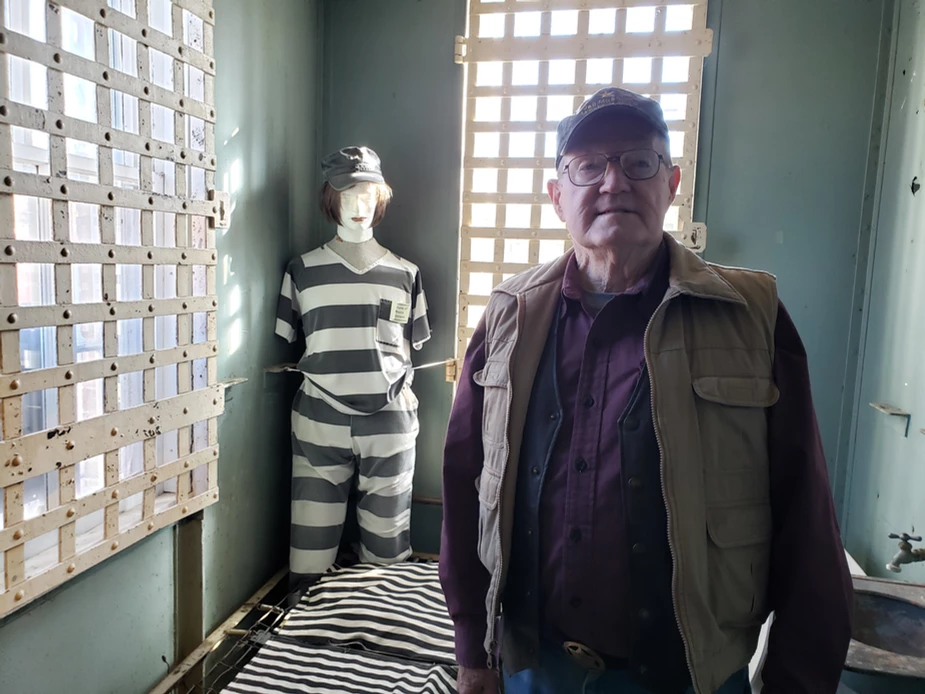By Elena Cawley | Special to The Times

Step back in time and hear stories about Moore County heroes and villains when you visit Lynchburg-Moore County Old Jail Museum on the square in Lynchburg. The structure was built in 1893 and used as a jail until 1990. When you enter the building, you’ll see the cells, where inmates resided. Artifacts, including photos, prisoner outfits and soldier uniforms, cover the walls, fill the shelves, and tell the story of Lynchburg and its residents. The Old Jail Museum is the only museum in Moore County, and it serves as a county history museum, preserving the past for future generations.
Bobby Fuller, the curator of the museum, meets guests and shows them the exhibits. Fuller has served as curator for 11 years. He was a policeman before. He is also one of the few people actually born in Moore County.
“There’s no hospital,” he said. “I was born at home.”
In 1970, he joined the police force.
“I was a policeman until I got to retirement age,” he said.
While he was ready to retire from the police department, he still wanted to stay busy. He now enjoys welcoming guests to the museum, sharing his experience and talking with visitors about the history of Moore County.
“The jail was built in 1893 at a cost of under $600,” Fuller said. “It was used until 1990. The court and the state inspector said it had to be closed. We got too many lawsuits … it was violating the prisoners’ civil rights because it was too cramped up. So they had to build a new jail. The capacity of the old jail was 16. You could put four beds in each cell. With 16 beds in the whole jail, when you got more than 20 inmates in the jail, the excess had to sleep on the floor upstairs.”

The building was a house and a jail, housing the sheriff’s family as well as the inmates. The family’s residence consisted of a living room, two bedrooms, dining room and kitchen.
“And there was the sheriff’s office and jail,” Fuller said. “The biggest family that lived here had eight kids, so they had beds everywhere. And the momma of those eight kids got pneumonia. There wasn’t much they could do (to help her) then, so she died here in just two or three days.”
Not only did the sheriff’s family and inmates live in the same house but they also enjoyed the same food.
“The only good thing about being in jail here was that you got good food,” Fuller said. “The sheriff’s wife cooked for everybody – for the family and the prisoners. She just cooked extra, and they all got good food.”
From 1893 to 1990, 25 sheriffs worked to keep Moore County safe. Two of the sheriffs were women.
Pearl Ervin Hobbs was the first female sheriff. She replaced her husband, Wiley Oliver J. Hobbs, who died in office in 1932.

“Her husband was sheriff, and one night he fell dead here with a heart attack. The county officials asked her if she would be the sheriff until they got another one. I wouldn’t want her mad at me – she is serious-looking,” said Fuller, pointing to a picture of Pearl Ervin Hobbs.
Margaret Wiseman served from 1950-1952.
“She was a schoolteacher and got elected sheriff,” Fuller said. “She was a nice schoolteacher. I remember her – I was a kid then.”
The last sheriff conducting operations at the old jail was Mark Logan.
“His wife didn’t like living at the jail because they had a nicer house, so they moved out to their house,” Fuller said.
Fuller loves sharing his knowledge with visitors.
“My favorite part of serving as curator here is meeting all the people,” he said. “I meet a lot of nice people, who are on vacation, having fun. For years, when I was a policeman, I met people in a bad situation, usually. They had problems, so they called the police. Now, I meet people in a nicer situation.”
Fuller appreciates the opportunity to talk with both locals and visitors about the museum’s pieces – from the pictures and newspaper clippings to the cardboard cutout of Little Richard and the statue of Jack Daniel.
The museum is located at 231 Main St., Lynchburg. Visiting the museum is free, and donations are appreciated.•
{The Lynchburg Times is the only locally-owned newspaper in Lynchburg and also the only woman-owned newspaper in Tennessee. We cover Metro Moore County government, Jack Daniel’s Distillery, Nearest Green Distillery, Tims Ford State Park, Motlow State Community College, Moore County High School, Moore County Middle School, Lynchburg Elementary, Raider Sports, plus regional and state news.}
